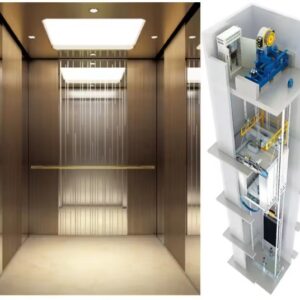Commercial Lifts and Elevators
Commercial lifts and elevators provide efficient vertical transportation in buildings, enhancing accessibility and convenience. They are designed for high traffic areas like offices, malls, and hospitals, ensuring safety and energy efficiency. With advanced technology and sleek designs, they improve mobility, optimize space, and comply with modern accessibility standards for seamless movement.
Product Description
Commercial Lifts and Elevators – Enhancing Vertical Mobility in Modern Spaces
Commercial lifts and elevators are essential for modern buildings, ensuring smooth and efficient vertical mobility for people and goods. These elevators are installed in offices, shopping malls, hospitals, hotels, and high-rise buildings to improve accessibility, convenience, and safety. Designed for high traffic and frequent use, they come with advanced technology, durable materials, and energy-efficient mechanisms to enhance performance and reliability. Businesses and property owners invest in commercial elevators to improve operational efficiency, increase property value, and comply with accessibility regulations.
Types of Commercial Lifts and Elevators
Modern commercial elevators are available in different types, including passenger lifts, freight elevators, service lifts, and panoramic glass elevators. Passenger lifts are the most common, designed to transport individuals between floors with ease and comfort. They come in various capacities and speeds, catering to buildings of different heights. Freight elevators are built for transporting heavy loads and goods, making them ideal for warehouses, factories, and shopping centers. Service lifts, often found in hotels and hospitals, assist staff in carrying supplies and equipment. Panoramic glass elevators offer a luxurious experience, commonly used in high-end commercial spaces, shopping malls, and hotels to provide stunning views while traveling between floors.
Safety Features in Commercial Elevators
Safety is a key factor in commercial lifts, with advanced features ensuring a secure ride for passengers. These elevators are equipped with emergency stop buttons, overload sensors, fire-resistant doors, backup power systems, and automatic braking mechanisms to prevent sudden drops. Smart control systems regulate speed, door operation, and passenger flow to enhance efficiency and safety. Many modern commercial elevators also include touchless controls, voice commands, and destination dispatch technology to minimize waiting times and improve user experience.
Energy Efficiency and Sustainability
Energy efficiency is another important consideration for commercial elevators. Many modern lifts incorporate regenerative drive systems, LED lighting, and standby modes to reduce power consumption. This not only lowers operational costs but also aligns with sustainability initiatives for green building certifications. Property developers and business owners prioritize energy-efficient elevator solutions to minimize environmental impact while maintaining high performance.
Modern Design and Customization
Design and aesthetics play a significant role in commercial elevator installations. Modern elevators are available in various finishes, including stainless steel, glass, and wood paneling, allowing businesses to align them with the building’s interior design. Customizable lighting, digital screens, and music systems enhance passenger experience, creating a sophisticated and comfortable ambiance. High-speed elevators in skyscrapers are designed with smooth acceleration and deceleration systems to provide a seamless ride without discomfort.
Installation and Maintenance
Installation and maintenance of commercial elevators require professional expertise and adherence to strict safety standards. Regular inspections, lubrication, and system updates are essential to ensure smooth operation and prevent technical failures. Leading elevator manufacturers offer maintenance contracts, including 24/7 emergency support, to keep lifts in optimal condition and extend their lifespan. Compliance with international safety regulations, such as those set by ASME and EN standards, ensures that commercial lifts meet the highest industry requirements.
The Future of Commercial Elevators
The demand for commercial lifts and elevators continues to rise as urbanization and high-rise developments increase globally. Businesses invest in smart and efficient elevator systems to enhance productivity and customer satisfaction. With advancements in technology, including AI-powered predictive maintenance and IoT connectivity, the future of commercial elevators promises greater efficiency, safety, and convenience for modern buildings.













Reviews
There are no reviews yet.